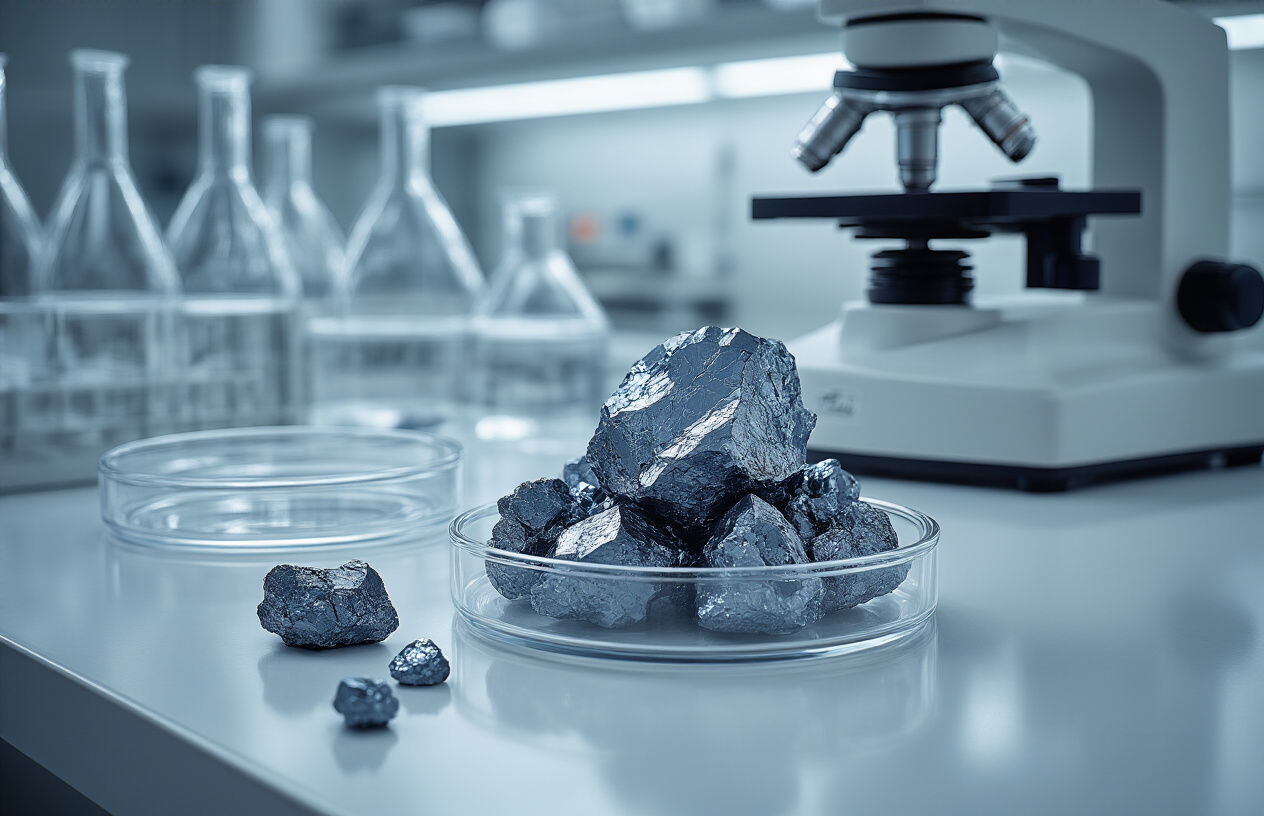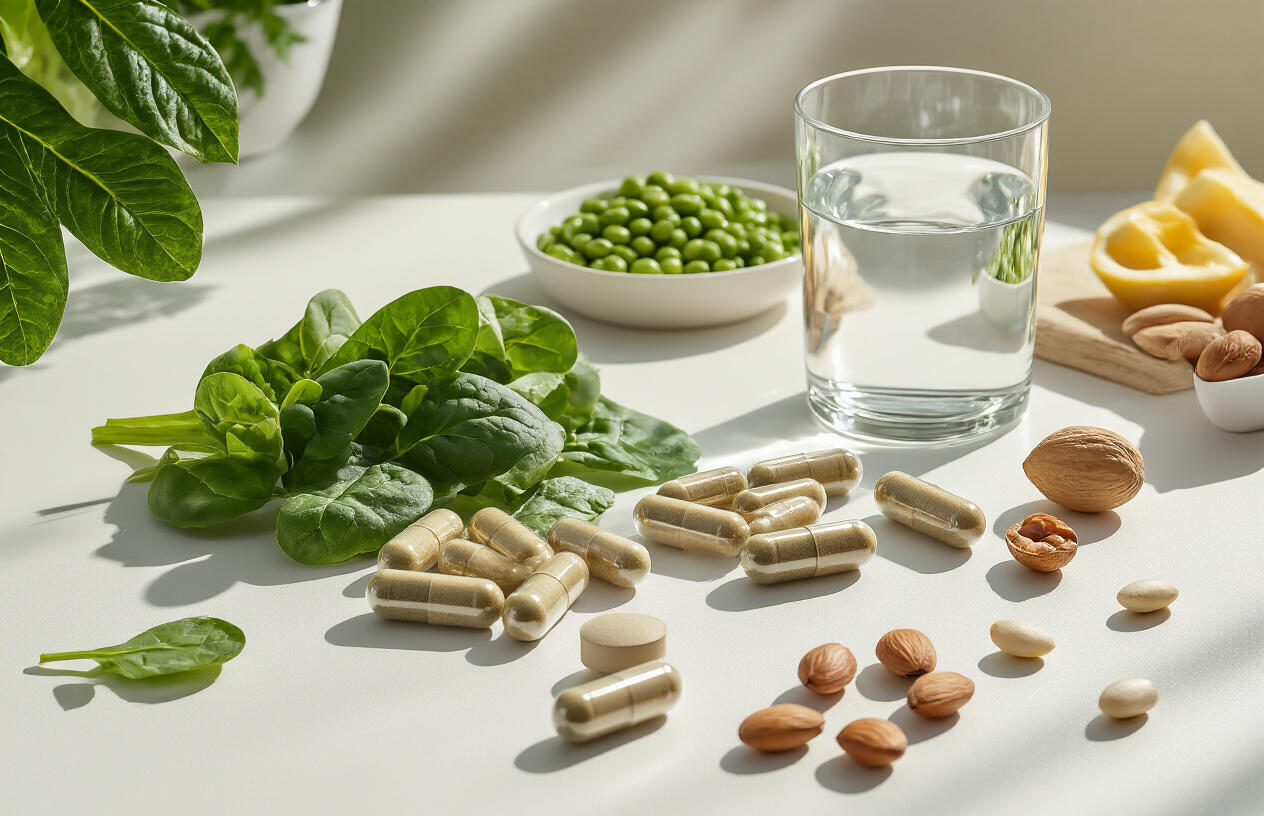Molybdenum might not be as famous as vitamin C or calcium, but this trace mineral plays a crucial role in keeping your body running smoothly. If you’re curious about lesser-known nutrients that pack a serious health punch, or you’re dealing with unexplained fatigue and wondering if a mineral deficiency could be the culprit, you’re in the right place.
This guide breaks down everything you need to know about molybdenum and its essential role in health. We’ll explore how this mighty mineral powers critical body functions like detoxification and metabolism, plus reveal which everyday foods can help you meet your daily needs. You’ll also learn how to spot the warning signs of deficiency and discover whether supplementation makes sense for your health goals.
Understanding Molybdenum as a Vital Trace Mineral

What Makes Molybdenum Essential for Human Health
Your body needs molybdenum to function properly, even though it only requires tiny amounts. This trace mineral acts as a cofactor for several critical enzymes that your body can’t live without. The most important of these enzymes include sulfite oxidase, xanthine oxidase, and aldehyde oxidase.
Sulfite oxidase helps break down sulfur-containing amino acids from the proteins you eat. Without enough molybdenum, toxic sulfites can build up in your system, potentially causing serious health problems including neurological damage. Xanthine oxidase plays a key role in producing uric acid, which your body needs in balanced amounts for proper cellular function.
Your liver depends heavily on molybdenum-containing enzymes to detoxify harmful substances. These enzymes help process medications, environmental toxins, and other foreign compounds that enter your body. This detoxification process protects your cells from damage and keeps your organs functioning smoothly.
Molybdenum also supports your body’s ability to mobilize iron from storage sites. This connection means that molybdenum deficiency can indirectly affect your iron status and potentially contribute to anemia-like symptoms.
How Your Body Absorbs and Utilizes This Crucial Nutrient
Your body absorbs molybdenum quite efficiently compared to many other minerals. When you eat molybdenum-containing foods, your stomach and small intestine quickly take up about 88-93% of the mineral. This high absorption rate means that what you eat directly impacts your molybdenum levels.
Once absorbed, molybdenum travels through your bloodstream bound to proteins. Your liver becomes the primary storage site, holding about 35% of your body’s total molybdenum. Your kidneys, bones, and other tissues store the rest.
The absorption process works differently than many other minerals. Unlike iron or zinc, which can compete with each other for absorption, molybdenum doesn’t face much competition in your digestive system. However, high levels of copper and sulfate can interfere with molybdenum absorption and increase excretion through your urine.
Your kidneys tightly control molybdenum levels in your body. When you have enough, your kidneys efficiently remove excess amounts through urine. This regulation system helps prevent molybdenum toxicity under normal dietary conditions.
The Difference Between Molybdenum and Other Trace Elements
Molybdenum stands apart from other trace minerals in several important ways. While minerals like iron and zinc are needed in relatively larger amounts (measured in milligrams), your body only needs micrograms of molybdenum daily. This puts molybdenum in an even more exclusive category of ultra-trace elements.
The bioavailability of molybdenum differs dramatically from minerals like iron or calcium. Your body absorbs molybdenum easily regardless of your nutritional status, while iron absorption depends heavily on whether you’re deficient or have adequate stores.
| Mineral | Daily Requirement | Absorption Rate | Primary Function |
|---|---|---|---|
| Molybdenum | 45 mcg | 88-93% | Enzyme cofactor |
| Iron | 8-18 mg | 10-18% | Oxygen transport |
| Zinc | 8-11 mg | 20-40% | Immune function |
| Copper | 900 mcg | 55-75% | Energy production |
Unlike iron, which your body stores extensively in ferritin, molybdenum doesn’t have a dedicated storage system. Your body maintains relatively constant levels by adjusting excretion rather than storage.
Molybdenum toxicity is extremely rare from food sources, while other trace elements like iron can easily reach toxic levels. This safety margin makes molybdenum unique among essential minerals.
Critical Health Functions Powered by Molybdenum

Enzyme Activation That Drives Cellular Energy Production
Molybdenum acts as a cofactor for three essential enzymes that keep your body’s energy systems running smoothly. The most important of these is xanthine oxidase, which breaks down purines from old DNA and RNA into uric acid for elimination. This process recycles cellular components and prevents the buildup of toxic waste products that could damage your cells.
Another key enzyme, aldehyde oxidase, metabolizes aldehydes – compounds that naturally form during various metabolic processes. Without adequate molybdenum, these aldehydes can accumulate and interfere with normal cellular function, leaving you feeling sluggish and drained.
The third enzyme, sulfite oxidase, plays a crucial role in sulfur metabolism. This enzyme converts potentially harmful sulfites into safer sulfates, protecting your cells from oxidative damage while maintaining proper energy production pathways. When molybdenum levels are optimal, these three enzymes work in harmony to keep your cellular machinery operating at peak efficiency.
Detoxification Processes That Protect Your Liver and Kidneys
Your liver and kidneys work around the clock to filter toxins from your blood, and molybdenum-dependent enzymes are central to this process. Sulfite oxidase in your liver converts sulfites from food preservatives and natural metabolism into harmless sulfates that your kidneys can easily eliminate.
Aldehyde oxidase helps your liver break down alcohol and other aldehydes that enter your system through food, medications, or environmental exposure. This enzyme transforms these potentially harmful compounds into safer substances that won’t damage your liver cells over time.
Xanthine oxidase supports kidney function by processing nitrogen-containing waste products from protein breakdown. This enzyme ensures that toxic compounds don’t accumulate in your bloodstream, reducing the workload on your kidneys and helping maintain healthy blood pressure levels.
Without sufficient molybdenum, these detoxification pathways slow down significantly. Your liver becomes less efficient at processing toxins, and your kidneys struggle to maintain proper waste elimination, potentially leading to fatigue, headaches, and other symptoms of toxic buildup.
Amino Acid Metabolism for Optimal Protein Utilization
Molybdenum plays a vital role in breaking down sulfur-containing amino acids like methionine and cysteine, which are building blocks for many important proteins in your body. These amino acids are found in high-quality protein sources like eggs, fish, and lean meats.
The breakdown of these amino acids produces sulfites as a byproduct, which must be quickly converted to sulfates by sulfite oxidase to prevent cellular damage. This process ensures that your body can efficiently use the amino acids for building muscle, producing enzymes, and maintaining healthy skin, hair, and nails.
Methionine metabolism is particularly important because it produces compounds essential for DNA methylation – a process that controls gene expression and cellular repair. When molybdenum levels are adequate, this pathway functions smoothly, supporting healthy aging and reducing oxidative stress.
Poor amino acid metabolism due to molybdenum deficiency can lead to incomplete protein utilization, meaning you might not get the full benefit from the protein you eat, regardless of how much you consume.
Sulfite Processing to Prevent Harmful Accumulation
Sulfites occur naturally in your body as byproducts of normal metabolism, and they’re also commonly found in processed foods as preservatives. While small amounts are harmless, excessive sulfite buildup can cause serious health problems, including breathing difficulties, headaches, and digestive issues.
Sulfite oxidase, which depends entirely on molybdenum to function, converts these sulfites into sulfates at an impressive rate – processing thousands of molecules per second when your molybdenum status is optimal. This rapid conversion prevents sulfite accumulation and protects your nervous system from damage.
People with sulfite sensitivity often have reduced sulfite oxidase activity, making them more vulnerable to reactions from foods containing sulfite preservatives. Ensuring adequate molybdenum intake can help improve sulfite tolerance and reduce sensitivity reactions.
The sulfates produced by this process aren’t just waste products – they’re actually useful compounds that support joint health, detoxification, and proper cellular communication throughout your body.
Daily Molybdenum Requirements for Optimal Wellness

Age-Specific Dosage Recommendations for Maximum Benefit
Understanding how much molybdenum your body needs changes dramatically throughout your life. The Recommended Dietary Allowance (RDA) varies based on age, with infants requiring the smallest amounts and adults needing the most.
| Age Group | RDA (micrograms/day) |
|---|---|
| Infants 0-6 months | 2 mcg |
| Infants 7-12 months | 3 mcg |
| Children 1-3 years | 17 mcg |
| Children 4-8 years | 22 mcg |
| Children 9-13 years | 34 mcg |
| Teens 14-18 years | 43 mcg |
| Adults 19+ years | 45 mcg |
These amounts might seem tiny compared to other nutrients, but molybdenum’s power lies in its precision. Your body uses this trace mineral with remarkable efficiency, meaning even small quantities can have significant health impacts.
Adults typically maintain stable molybdenum needs throughout their lives, with the 45-microgram daily requirement staying consistent from age 19 onward. Children experience the most dramatic changes in their molybdenum needs as their bodies grow and develop new enzymatic systems that depend on this mineral.
Most people easily meet these requirements through regular food consumption, as molybdenum appears naturally in many common foods. The upper tolerable limit for adults sits at 2,000 micrograms daily, providing a substantial safety margin above normal dietary intake levels.
Special Considerations for Pregnant and Nursing Women
Pregnancy and breastfeeding create unique molybdenum demands that require careful attention. Pregnant women need exactly the same amount as other adults – 45 micrograms daily – but their absorption and utilization patterns change significantly.
During pregnancy, your body becomes more efficient at absorbing molybdenum from food sources. This natural adaptation helps ensure adequate supply for both maternal health and fetal development. The developing baby relies on maternal molybdenum stores to build essential enzyme systems, particularly those involved in amino acid metabolism and detoxification processes.
Nursing mothers face increased molybdenum requirements, needing 50 micrograms daily. This 5-microgram increase might seem small, but it reflects the body’s need to maintain adequate levels while transferring molybdenum through breast milk. The concentration of molybdenum in breast milk directly correlates with maternal intake, making consistent dietary sources essential.
Women who experienced molybdenum deficiency before pregnancy may need additional monitoring. Pre-pregnancy nutritional status significantly influences how well the body manages molybdenum during these demanding periods. Healthcare providers often recommend comprehensive nutritional assessments for women planning pregnancies, ensuring optimal molybdenum status before conception occurs.
Breastfeeding duration also affects maternal molybdenum needs. Extended nursing periods may require sustained attention to molybdenum-rich foods to prevent depletion of maternal stores.
How Individual Health Conditions Affect Your Molybdenum Needs
Certain health conditions can dramatically alter how your body processes molybdenum, creating situations where standard recommendations don’t apply. Understanding these variations helps optimize your molybdenum intake for your specific health circumstances.
Digestive disorders represent the most common category affecting molybdenum absorption. Conditions like Crohn’s disease, celiac disease, and chronic diarrhea can reduce your body’s ability to extract molybdenum from food sources. People with these conditions might need higher dietary intake or supplementation to maintain adequate levels.
Kidney disease creates complex molybdenum challenges. While healthy kidneys efficiently regulate molybdenum excretion, compromised kidney function can lead to accumulation. Individuals with chronic kidney disease often require careful monitoring and potentially restricted molybdenum intake to prevent toxic buildup.
Genetic variations in molybdenum-dependent enzymes can create unique requirements. Some people inherit enzyme variants that work less efficiently, potentially increasing their molybdenum needs. These genetic factors aren’t always obvious and might only become apparent through specialized testing or when unexplained symptoms develop.
Medication interactions also influence molybdenum status. Certain drugs can interfere with molybdenum absorption or increase excretion rates. People taking long-term medications should discuss potential molybdenum interactions with their healthcare providers.
Chronic inflammatory conditions may increase molybdenum utilization as the body works harder to process metabolic byproducts. Autoimmune diseases, chronic infections, and persistent inflammatory states can all elevate molybdenum requirements beyond standard recommendations.
Age-related changes in absorption efficiency mean older adults might benefit from slightly higher intakes, even though official recommendations remain constant throughout adulthood.
Top Food Sources to Boost Your Molybdenum Intake

Legumes and Grains That Deliver High Molybdenum Content
Black-eyed peas top the charts when it comes to molybdenum-rich foods, packing an impressive 180 micrograms per cup. Lima beans follow closely behind, offering about 142 micrograms per serving. Lentils provide another excellent source, delivering roughly 148 micrograms per cooked cup while also supplying protein and fiber.
Oats stand out among grains as a molybdenum powerhouse, containing approximately 26 micrograms per cup of cooked oatmeal. Wheat-based products like whole grain bread and pasta contribute meaningful amounts too, though the exact content varies depending on growing conditions.
| Food Item | Molybdenum Content (per cup) | Additional Benefits |
|---|---|---|
| Black-eyed peas | 180 mcg | High protein, folate |
| Lima beans | 142 mcg | Fiber, potassium |
| Lentils | 148 mcg | Iron, protein |
| Cooked oats | 26 mcg | Beta-glucan fiber |
Rice contributes smaller but still valuable amounts of molybdenum, particularly brown rice varieties. Barley and quinoa also provide decent quantities while delivering complete proteins and essential amino acids.
Vegetables and Nuts Rich in This Essential Mineral
Leafy greens like spinach and kale contain moderate amounts of molybdenum, typically ranging from 8-15 micrograms per cooked cup. Broccoli and cauliflower contribute similar levels while providing vitamin C and antioxidants.
Sunflower seeds offer one of the highest molybdenum concentrations among nuts and seeds, containing about 56 micrograms per quarter cup. Almonds and cashews provide smaller amounts but remain worthwhile sources when eaten regularly.
Potatoes, especially when eaten with the skin, deliver approximately 8 micrograms per medium potato. Sweet potatoes contain similar levels while adding beta-carotene and vitamin A to your diet.
How Soil Quality Affects Molybdenum Levels in Foods
The molybdenum content in foods varies dramatically based on soil conditions where crops grow. Plants absorb this mineral directly from soil, making geological factors crucial determinants of nutritional content.
Alkaline soils typically contain higher available molybdenum levels compared to acidic soils. Volcanic soils often show elevated concentrations, while sandy soils may contain less bioavailable forms of the mineral.
Agricultural practices also impact molybdenum availability. Farmers sometimes add molybdenum-containing fertilizers to correct deficiencies, particularly in areas with naturally low soil levels. Organic farming methods may result in different molybdenum concentrations depending on soil management approaches.
Geographic location plays a major role too. Foods grown in certain regions like parts of California, Nevada, and some areas of China tend to have higher molybdenum content due to natural geological deposits.
Smart Food Combinations for Enhanced Absorption
Pairing molybdenum-rich foods with certain nutrients can optimize absorption and utilization. Combining legumes with vitamin C sources like bell peppers or citrus fruits may enhance overall mineral absorption.
Eating molybdenum sources alongside foods containing sulfur amino acids, found in eggs and meat, supports the mineral’s role in enzyme function. This combination helps your body make the most of the molybdenum you consume.
Avoid consuming large amounts of copper-rich foods at the same meal as high-molybdenum foods, as these minerals can compete for absorption. Space out foods like liver or shellfish from your main molybdenum sources when possible.
Including a variety of molybdenum sources throughout the day rather than concentrating them in one meal helps maintain steady levels and supports consistent enzyme activity.
Recognizing and Addressing Molybdenum Deficiency

Warning Signs Your Body May Be Lacking This Mineral
Molybdenum deficiency rarely appears with obvious symptoms, making it challenging to spot. Unlike deficiencies in iron or vitamin D, your body doesn’t send clear warning signals when molybdenum levels drop. Most people only discover low molybdenum status through comprehensive blood tests.
When symptoms do occur, they often mirror other nutritional deficiencies. You might experience persistent fatigue that doesn’t improve with rest, unexplained mood changes, or difficulty concentrating. Some people report increased sensitivity to certain foods, particularly those containing sulfites found in wine, dried fruits, and processed foods.
Hair and nail changes can signal potential deficiency. Your hair might become brittle or grow more slowly than usual, while nails may develop ridges or break easily. These changes happen gradually, making them easy to dismiss as normal aging or stress-related issues.
Digestive problems occasionally accompany low molybdenum levels. You might notice increased bloating after meals or changes in your body’s ability to process certain proteins. Sleep disturbances and headaches can also occur, though these symptoms are common to many conditions.
Health Conditions Linked to Insufficient Molybdenum Levels
Several serious health conditions connect to inadequate molybdenum intake, though these relationships are still being studied. Researchers have found links between low molybdenum status and increased cancer risk, particularly esophageal and stomach cancers. Population studies show higher cancer rates in regions with molybdenum-poor soil.
Cardiovascular problems may develop when molybdenum levels remain low for extended periods. This trace mineral helps your body process sulfur-containing amino acids, which play crucial roles in heart health. Without adequate molybdenum, harmful compounds can accumulate in your cardiovascular system.
Kidney stone formation increases in people with molybdenum deficiency. This mineral helps break down purines, preventing uric acid buildup that contributes to stone formation. People with recurring kidney stones often show lower molybdenum levels than healthy individuals.
Neurological symptoms can emerge from severe deficiency, including seizures, developmental delays in children, and cognitive impairment in adults. These conditions are rare but serious, highlighting molybdenum’s importance for proper nervous system function.
Some autoimmune conditions may worsen with low molybdenum status, as this mineral supports enzyme systems involved in detoxification and immune regulation.
Risk Factors That Increase Your Chances of Deficiency
Geographic location significantly impacts your molybdenum intake. People living in areas with molybdenum-depleted soil face higher deficiency risks. Certain regions in China, Iran, and parts of the United States have naturally low soil molybdenum content, affecting local food supplies.
Your diet plays the biggest role in molybdenum status. Vegetarians and vegans generally maintain adequate levels due to high consumption of legumes, grains, and leafy vegetables. However, people following restrictive diets or eating primarily processed foods may struggle to meet their needs.
Age affects molybdenum absorption and utilization. Older adults often have reduced stomach acid production, which can impair mineral absorption. Additionally, certain medications commonly prescribed to seniors interfere with molybdenum uptake.
Genetic variations influence how efficiently your body processes molybdenum. Some people carry genetic mutations affecting molybdenum-dependent enzymes, requiring higher intake to maintain normal function. These variations are rare but can significantly impact individual needs.
Chronic digestive conditions increase deficiency risk. Crohn’s disease, celiac disease, and other inflammatory bowel conditions damage intestinal lining, reducing mineral absorption. People with these conditions need careful monitoring of their molybdenum status.
Excessive copper or tungsten intake can interfere with molybdenum absorption, creating functional deficiency even with adequate intake.
Effective Strategies to Restore Healthy Molybdenum Status
Dietary changes offer the most practical approach to improving molybdenum levels. Focus on incorporating molybdenum-rich foods into your daily meals. Legumes provide excellent sources – add lentils to soups, chickpeas to salads, or black beans to your favorite dishes. A single cup of cooked lentils delivers roughly 150 micrograms of molybdenum.
Whole grains significantly boost your intake. Replace refined grains with quinoa, brown rice, oats, and whole wheat products. These foods not only provide molybdenum but also offer fiber and other essential nutrients that support overall health.
Dark leafy greens deserve regular spots on your plate. Spinach, kale, and other greens contain substantial molybdenum amounts while providing vitamins and antioxidants. Raw or lightly cooked preparations preserve the highest mineral content.
Nuts and seeds make convenient molybdenum sources for snacking or meal additions. Sunflower seeds, almonds, and peanuts all contribute meaningful amounts to your daily intake.
If dietary changes aren’t sufficient, targeted supplementation might be necessary. Work with a healthcare provider to determine appropriate dosing, as molybdenum requirements vary significantly between individuals. Standard multivitamins often contain inadequate amounts for people with deficiency.
Address underlying absorption issues simultaneously. Treat digestive conditions, review medications that might interfere with mineral uptake, and consider digestive enzyme support if recommended by your healthcare provider.
Regular monitoring helps track progress and prevent overcorrection, as excessive molybdenum intake can cause copper deficiency and other complications.
Molybdenum Supplementation for Enhanced Health Benefits

When Supplements Become Necessary for Optimal Health
Most people get enough molybdenum from their regular diet, but certain situations make supplementation worth considering. People with digestive disorders like Crohn’s disease or celiac disease often struggle to absorb nutrients properly, including trace minerals. Those following extremely restrictive diets or living in areas with molybdenum-poor soil might also fall short.
Individuals with specific genetic variations affecting molybdenum-dependent enzymes may benefit from higher intakes. Chronic kidney disease patients sometimes need careful monitoring and potential supplementation, as their mineral processing gets disrupted.
Healthcare providers typically recommend supplements when blood tests reveal deficiency or when someone has conditions that interfere with normal molybdenum metabolism. Rather than guessing, getting tested gives you the clearest picture of your needs.
Choosing the Right Form and Dosage for Your Needs
Molybdenum supplements come in several forms, with sodium molybdate and molybdenum glycinate being the most common. Sodium molybdate offers excellent bioavailability and remains the standard choice for most people. Molybdenum glycinate, an amino acid-chelated form, may provide gentler absorption for sensitive individuals.
Standard dosages range from 50 to 200 micrograms daily, though most people need far less. The recommended dietary allowance sits at just 45 micrograms for adults. Higher doses should only be taken under medical supervision.
| Form | Absorption Rate | Best For |
|---|---|---|
| Sodium Molybdate | High | General supplementation |
| Molybdenum Glycinate | Moderate-High | Sensitive stomachs |
| Molybdenum Picolinate | High | Enhanced bioavailability |
Look for third-party tested products from reputable manufacturers. Many multivitamin formulas include molybdenum in appropriate amounts, which often proves more cost-effective than standalone supplements.
Potential Side Effects and Safety Considerations
Molybdenum has an impressive safety profile at recommended doses. The body efficiently regulates molybdenum levels, excreting excess amounts through urine. Most people experience no side effects when taking appropriate doses.
Excessive intake beyond 2,000 micrograms daily can cause problems. High doses may lead to copper deficiency, as molybdenum interferes with copper absorption. Symptoms of copper deficiency include anemia, bone problems, and immune system issues.
Some people report mild digestive upset when first starting supplements. Taking molybdenum with food usually resolves this issue. Rare cases of allergic reactions have been reported, typically involving skin rashes or breathing difficulties.
Pregnant and breastfeeding women should stick to food sources unless their doctor specifically recommends supplementation. Children need much smaller amounts than adults, so adult supplements are inappropriate for young ones.
People taking medications should consult their healthcare provider before adding molybdenum supplements. While interactions are uncommon, it’s better to check with medical professionals who understand your complete health picture.

Molybdenum might not get the spotlight like other minerals, but it’s working behind the scenes to keep your body running smoothly. From helping enzymes do their job to supporting your liver’s detox processes, this trace mineral plays a bigger role in your health than you might think. The good news is that most people can easily meet their daily needs through simple food choices like beans, nuts, and leafy greens.
Don’t wait for deficiency symptoms to show up before paying attention to your mineral intake. Take a quick look at your diet and see if you’re getting enough molybdenum-rich foods. If you’re eating a balanced diet with plenty of whole foods, you’re probably already on the right track. For those who might need extra support, talking to a healthcare provider about supplementation could be a smart move to keep your body functioning at its best.












